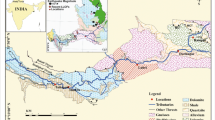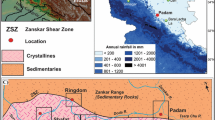Abstract
In the present paper we study morphology, occurrence and mutual interrelationship of erosional (amphitheaters) and depositional landforms belonging to glacial (moraines), fluvio-glacial (glacial out wash), mass wasting (alluvial fans), aeolian (obstacle dune and sand sheets) and lacustrine (palaeo-lake sediments) processes within the Leh valley. These landforms are the geomorphic expression of past deglaciation grouped into five Formative Stages of Landform (FSL 1 to FSL 5) development in the Leh valley. The broad age bracket for the formative stages are based on the empirical relationship of the landforms, available chronology and their correlation with comparable climate phases. The retreat of glaciers in the Leh valley, along the southern slopes of Ladakh hill range and their retention over the northern slopes and Karakoram is further explained.
Similar content being viewed by others
References
Bagati, T. N., Mazari, R.K. and Rajagopalan, G. (1996) Palaeotectonic implication of Lamayuru lake (Ladakh). Curr. Sci., v.71, pp.479–482.
Bagati, T.N. and Thakur, V. C. (1993) Quaternary basins of Ladakh and Lahaul-Spiti in northwestern Himalaya. Curr. Sci., v.64, pp.898–903.
Bhutiyani, M.R., Kale, V.S. and Pawar, N.J. (2007) Long-term trends in maximum, minimum and mean annual air temperatures across the Northwestern Himalaya during the twentieth century. Climatic Change, v.85, pp.159–177.
Brown, E.T., Bendick, R., Bourles, D.L., Gaur, V., Molnar, P., et al. (2002) Slip rates of the Karakorum fault, Ladakh, India, determined using cosmic ray exposure dating of debris flows and moraines. Jour. Geophys. Res, v.107, pp.2192.
Burbank, D.W. and Fort, M.B. (1985) Bedrock control on glacial limits: Examples from the Ladakh and Zanskar ranges, northwestern Himalaya, India. Jour. Glaciology, v.31, pp.143–149.
Burgisser, H. M., Gansser, A. and Pika, J. (1982) Late Glacial lake sediments of the Indus valley area, northwestern Himalayas. Eclogae Geologicae Helvetiae, v.75, pp.51–63.
Clift, P.D., Campbell, I.H., Pringle, M.S., Carter, A., Zhang, X., et al. (2004) Thermochronology of the modern Indus River bedload: New insight into the controls on the marine stratigraphic record. Tectonics, v.23, pp.1–17.
Coleman, M. and Hodges, K. (1995) Evidence for Tibetan plateau uplift before 14 Myr ago from a new minimum age for eastwest extension. Nature, v.374, pp.49–52.
Damm, B. (2006) Late Quaternary glacier advances in the upper catchment area of the Indus River (Ladakh and western Tibet). Quaternary International, v.154, pp.87–99.
Dansgaard, W., Johnsen, S.J., Clausen, H.B., Dahl-Jensen, D., Gundestrup, N.S. et al., (1993) Evidence for general instability of past climate from a 250-kyr ice-core record. Nature, v.364, pp.218–220.
Fort, M. (1983) Geomorphological observations in the Ladakh area (Himalayas): Quaternary evolution and present dynamics Stratigraphy and Structure of Kashmir and Ladakh Himalaya. Hindustan Publishers, Delhi, India, pp.39–58.
Fort, M., Burbank, D.W. and Freytet, P. (1989) Lacustrine sedimentation in a semiarid alpine setting: an example from Ladakh, Northwestern Himalaya. Quaternary Res., v.31, pp.332–350.
Fowler, H.J. and Archer, D.R. (2006) Conflicting signals of climatic change in the Upper Indus Basin. Jour. Climate, v.19, pp.4276–4293.
Garzanti, E. and van Haver, T. (1988) The Indus clastics: forearc basin sedimentation in the Ladakh Himalaya (India). Sedimentary Geol., v.59, pp.237–249.
Grip, M. (1993) Climate instability during the last interglacial period recorded in the GRIP ice core. Nature, v.364, pp.203–207.
Heyman, J., A. Stroeven, J. Harbor and M. Caffee, (2009) Cosmogenic exposure ages of glacial boulders from the Tibetan Plateau-Age distributions support boulder exhumation/erosion and indicate old glacial deposits. Geophys. Res. Abstracts.
Hewitt, K., (2005) The Karakoram anomaly? Glacier expansion and the ‘elevation effect’, Karakoram Himalaya Mountain. Research and Development, v.25, pp.332–340.
Jade, S., Bhatt, B.C., Yang, Z., Bendick, R., Gaur, V.K. et al. (2004) GPS measurements from the Ladakh Himalaya, India: Preliminary tests of plate-like or continuous deformation in Tibet. Geol. Soc. Amer. Bull., v.116, pp.1385–1391.
Jamieson, S.S.R., Sinclair, H.D., Kirstein, L.A. and Purves, R.S. (2004)Tectonic forcing of longitudinal valleys in the Himalaya: morphological analysis of the Ladakh Batholith, North India. Geomorphology, v.58, pp.49–65.
Juyal, N. (2010) Cloud burst-triggered debris flows around Leh. Curr. Sci., v.99, pp.1166.
Kotlia, B.S., Hinz-Schallreuter, I., Schallreuter, R. and Schwarz, J. (1998) Evolution of Lamayuru palaeolake in the Trans Himalaya: Palaeoecological implications. Eiszeitalter und Gegenwart, v.48, pp.177–191.
Lambs, L., Balakrishna, K., Brunet, F. and Probst, J.L. (2005) Oxygen and hydrogen isotopic composition of major Indian rivers: a first global assessment. Hydrological Processes, v.19, pp.3345–3355.
Macgregor, K.R., Anderson, R.S., Anderson, S.P. and Waddington, E.D. (2000) Numerical simulations of glacialvalley longitudinal profile evolution. Geology, v.28, pp.1031–1034.
Mitchell, W. A., Taylor, P. J. and Osmaston, H. (1999) Quaternary geology in Zanskar, NW Indian Himalaya: evidence for restricted glaciation and preglacial topography. Jour. Asian Earth Sci., v.17, pp.307–318.
Moretti, M., Soria, J. Alfaro, P. and Walsh, N. (2001) Asymmetrical soft-sediment deformation structures triggered by rapid sedimentation in turbiditic deposits (Late Miocene, Guadix Basin, southern Spain). Facies, v.44, pp.283–294.
Osmaston, H. (1994) The geology, geomorphology and Quaternary history of Zanskar. In: J. Crook and H. Osmaston (Eds.), Himalayan Buddhist Villages: Environment, Resources, Society and Religious Life in Zangskar, Ladakh. Delhi: Motilal Banarsidass Publ., pp.1–36.
Owen, L.A. (2009) Latest Pleistocene and Holocene glacier fluctuations in the Himalaya and Tibet. Quaternary Sci. Rev., v.28, pp.2150–2164.
Owen, L.A. and Benn, D.I. (2005) Equilibrium-line altitudes of the Last Glacial Maximum for the Himalaya and Tibet: an assessment and evaluation of results. Quaternary Internat., v.138, pp.55–78.
Owen, L.A., Caffee, M.W., Bovard, K.R., Finkel, R.C. and Sharma, M.C. (2006) Terrestrial cosmogenic nuclide surface exposure dating of the oldest glacial successions in the Himalayan orogen: Ladakh Range, northern India. Geol. Soc. Amer. Bull., v.118, pp.383–392.
Phartiyal, B. and Sharma, A. (2009) Soft-sediment deformation structures in the Late Quaternary sediments of Ladakh: Evidence for multiple phases of seismic tremors in the North western Himalayan Region. Jour. Asian Earth Sci., v.34, pp.761–770.
Phartiyal, B., Sharma, A., Upadhyay, R., Ram, A. and Sinha, A.K. (2005) Quaternary geology, tectonics and distribution of palaeo- and present fluvio/glacio lacustrine deposits in Ladakh, NW Indian Himalaya-a study based on field observations. Geomorphology, v.65, pp.241–256.
Rangarajan, G., and Sant, D.A. (2000) Paleoclimatic data from 74KL and Guliya cores: New insights. Geophys. Res. Lett., v.27, pp.787–790.
Sant, D.A., Wadhawan, S.K., Ganjoo, R.K., Basavaiah, N., Sukumaran, P. et al., (Communicated) Linkage of Paraglacial Process from Last Glacial to Recent Inferred from Spituk Sequence, Leh valley, Ladakh Himalayas, India. Jour. Geol. Soc. India.
Searle, M., Corfield, R.I., B. E. N. Stephenson and J. O. E. Mccarron, (1997) Structure of the North Indian continental margin in the Ladakh-Zanskar Himalayas: implications for the timing of obduction of the Spontang ophiolite, India-Asia collision and deformation events in the Himalaya. Geological Magazine, v.134, pp.297–316.
Searle, M.P., Pickering, K.T. and Cooper, D.J.W. (1990) Restoration and evolution of the intermontane Indus molasse basin, Ladakh Himalaya, India. Tectonophysics, v.174, pp.301–314.
Seong, Y.B., Owen, L.A., Yi, C. and Finkel, R.C. (2009) Quaternary glaciation of Muztag Ata and Kongur Shan: Evidence for glacier response to rapid climate changes throughout the Late Glacial and Holocene in westernmost Tibet. Geol. Soc. Amer. Bull., v.121, pp.348–365.
Shukla, U.K., Kotlia, B.S. and Mathur, P.D. (2002) Sedimentation pattern in a trans-Himalayan Quaternary lake at Lamayuru (Ladakh), India. Sedimentary Geol., v.148, pp.405–424.
Sinclair, H.D. and Jaffey, N. (2001) Sedimentology of the Indus Group, Ladakh, northern India: implications for the timing of initiation of the palaeo-Indus River. Jour. Geol. Soc., v.158, pp.151–162.
Thakur, V.C. (1981) Regional framework and geodynamic evolution of the Indus-Tsangpo suture zone in the Ladakh Himalayas. Trans. Royal Soc. Edinburgh, v.72, pp.89–97.
Thompson, L.G., Mosley-Thompson, E., Davis, M.E., Mashiotta, T.A., Henderson, K.A. et al. (2006) Ice core evidence for asynchronous glaciation on the Tibetan Plateau Quaternary Internat., v.154, pp.3–10.
Thompson, L.G., Yao, T., Davis, M.E., Henderson, K.A., Mosleythompson, E. et al. (1997) Tropical climate instability: The last glacial cycle from a Qinghai-Tibetan ice core. Science, v.276, pp.1821–1825.
Upadhyay, R. (2001) Seismically-induced soft-sediment deformational structures around Khalsar in the Shyok Valley, northern Ladakh and eastern Karakoram, India. Curr. Sci., v.81, pp.600–604.
Upadhyay, R. (2003) Earthquake-induced soft-sediment deformation in the lower Shyok River valley, northern Ladakh, India. Jour. Asian Earth Sci., v.21, pp.413–421.
Vernekar, A.D., and Ji, Y. (1999) Simulation of the onset and intra-seasonal variability of two contrasting summer monsoons. Jour. Climate, v.12, pp.1707–1725.
Author information
Authors and Affiliations
Rights and permissions
About this article
Cite this article
Sant, D.A., Wadhawan, S.K., Ganjoo, R.K. et al. Morphostratigraphy and palaeoclimate appraisal of the Leh valley, Ladakh Himalayas, India. J Geol Soc India 77, 499–510 (2011). https://doi.org/10.1007/s12594-011-0057-9
Received:
Accepted:
Published:
Issue Date:
DOI: https://doi.org/10.1007/s12594-011-0057-9




